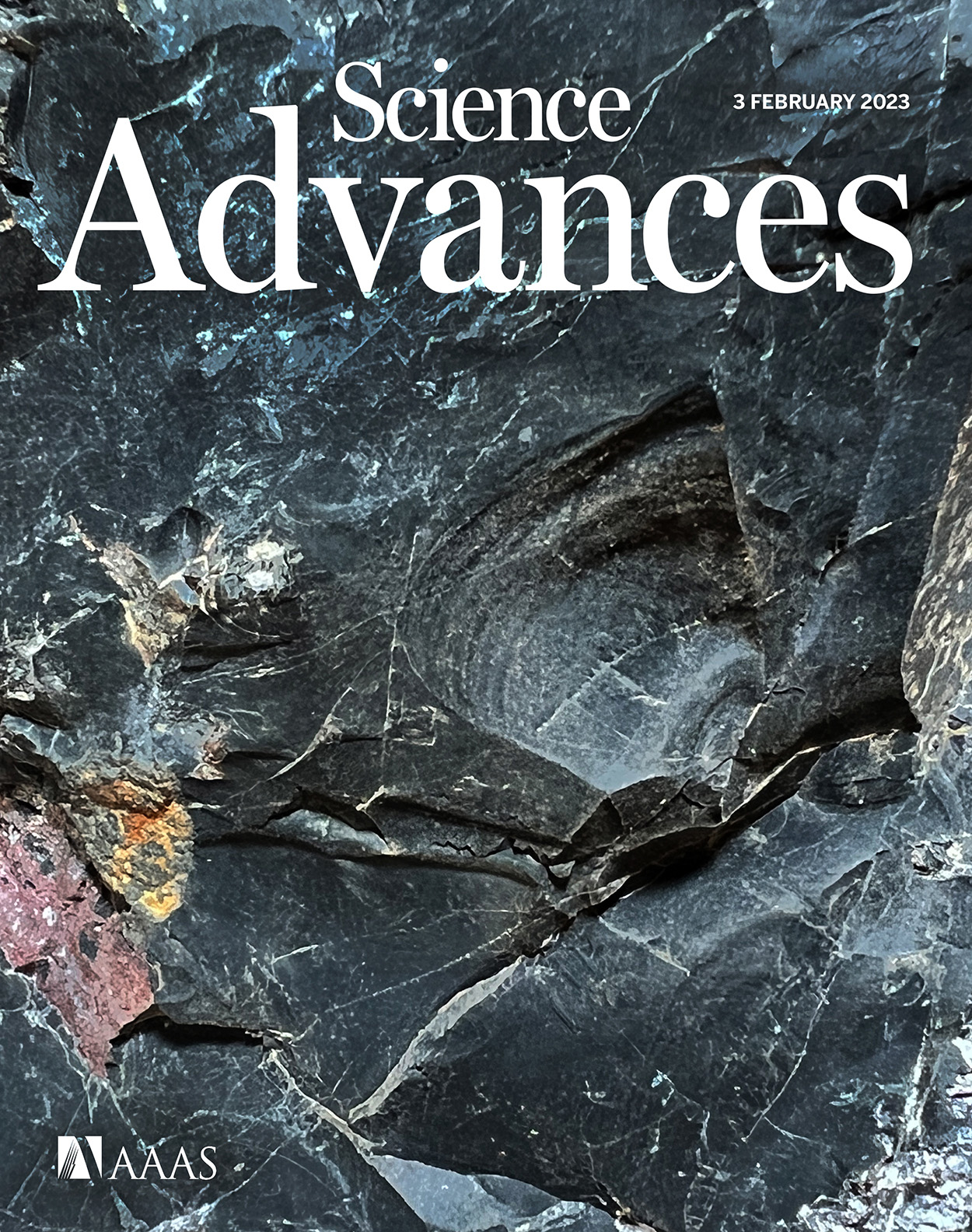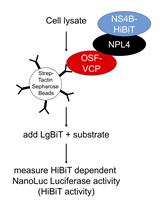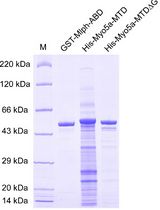- EN - English
- CN - 中文
Use of Open Surface Plasmon Resonance (OpenSPR) to Characterize the Binding Affinity of Protein–Protein Interactions
使用开放表面等离子共振 (OpenSPR) 表征蛋白质-蛋白质相互作用的结合亲和力
发布: 2023年09月05日第13卷第17期 DOI: 10.21769/BioProtoc.4795 浏览次数: 2833
评审: Emilia KrypotouGregory CravenSrajan KapoorQingliang Shen

相关实验方案
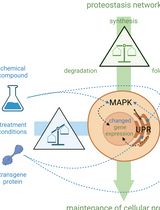
Cell-Sonar:通过特定蛋白标志物表达变化追踪目标蛋白的简便低成本方法
Sabrina Brockmöller [...] Simone Rothmiller
2025年02月05日 1609 阅读
Abstract
Surface Plasmon Resonance (SPR) is a label-free optical technique to assess protein–protein interaction kinetics and affinities in a real-time setting. Traditionally, Biacore SPR employs a continuous film of gold to detect any change in the angle of re-emitted light when the refractive index of a ligand conjugated to the flat gold surface is altered by its interaction with a local analyte. In contrast, the Nicoya Lifesciences’ OpenSPR technology uses gold nanoparticles to detect small changes in the absorbance peak wavelength of a conjugated ligand after its engagement by an analyte. Specifically, when broadband white light is shone onto the gold nanoparticles, it produces a strong resonance absorbance peak corresponding to the refractive index of a ligand conjugated to the surface of gold nanoparticles. Upon its interaction with an analyte, however, the absorbance wavelength peak of the conjugated ligand will be changed and timely recorded as sensorgrams of dynamic ligand–analyte interactions. Thus, the improvement in the detection method (from traditional detection of changes in the angle of re-emitted light to the contemporary detection of changes in the wavelength of the absorbance peak) features OpenSPR as a cost-effective and user-friendly technique for in-depth characterization of protein–protein interactions. Here, we describe the detailed method that we used to characterize procathepsin L (pCTS-L) interactions with two putative pattern recognition receptors (TLR4 and RAGE) using the 1st generation of Nicoya Lifesciences’ OpenSPR instrument with a 1-channel detection.
Key features
• Nicoya OpenSPR is a benchtop small-size equipment that provides in-depth label-free binding kinetics and affinity measurement for protein–protein interactions in real-time fashion.
• This technology is relatively intuitive and user-friendly for scientists at any skill level.
• OpenSPR sensors employ nanotechnology to reduce the cost of manufacturing complex optical hardware and Sensor Chips, and similarly reduce the consumption of precious analyte samples.
• The manufacturer provides online training for OpenSPR (Catalog: TRAIN-REMOTE) and TraceDrawer (Catalog: TRAIN-TD) to customer scientists.
Keywords: Procathepsin L (pCTS-L) (胰蛋白酶 L (pCTS-L))Background
In order to understand complex mechanisms underlying the regulation of various biological processes, it is often essential to characterize protein–protein interactions under many physiological or pathological conditions. For many years, surface plasmon resonance (SPR) has been widely used to analyze all types of interactions between protein–protein or protein and other molecules such as nucleic acids, lipids, and carbohydrates (Willander and Al-Hilli, 2009; Drescher et al., 2018). Traditionally, Biacore SPR uses a continuous film of gold to detect changes in the angle of re-emitted light when the refractive index of a ligand conjugated to the flat gold surface is altered by its interaction with a local analyte (Willander and Al-Hilli, 2009; Drescher et al., 2018). In contrast, the newly developed Nicoya Lifesciences’ OpenSPR employs gold nanoparticles to detect small changes in the absorbance peak wavelength of a conjugated ligand after its binding to an analyte. Nevertheless, both traditional SPR and contemporary OpenSPR can give real-time information about the binding kinetics and affinities of dynamic interactions between various molecules.
During the last few years, we have used Nicoya Lifesciences’ first generation 1-channel OpenSPR to determine the binding affinities between antigens and antibodies (Chen et al., 2020) or cytokines and putative receptors (Qiang et al., 2022; Zhu et al., 2023). Briefly, a ligand protein is immobilized onto nitrilotriacetic acid (NTA)-conjugated gold nanoparticles in a specific orientation, and an analyte solution is subsequently injected at several increasing concentrations into the microflow system. When broadband white light is shone onto the gold nanoparticles, it produces a strong resonance absorbance peak that is specific to the refractive index of a local ligand conjugated to the gold nanoparticles. If an analyte binds the ligand, it will induce a change in the wavelength of the absorbance peak of the ligand, which can be recorded in the sensorgram as an increase in the SPR signal. After a desired association time, a solution without the analyte is injected to dissociate the complex between ligand and analyte. If the analyte dissociates from the ligand, a decrease in SPR signal would be observed. By dividing the dissociation rate (koff) by the association rate (kon), the equilibrium dissociation constant (KD) can be calculated as a measure of the affinity between these specific ligand–analyte interactants. Thus, the improvement in the detection method (from traditional detection of changes in the angle of re-emitted light to the contemporary detection of changes in the wavelength of the absorbance peak) features OpenSPR as a cost-effective and user-friendly technique for in-depth characterization of protein–protein interactions. Here, we describe the detailed method that we used to characterize procathepsin L (pCTS-L) interaction with two putative pattern recognition receptors (TLR4 and RAGE) using Nicoya Lifesciences’ 1st generation OpenSPR instrument with a 1-channel detection (Zhu et al., 2023).
Materials and reagents
Reagents
Extracellular domain of human TLR4 (residue 1-631, 70.5 kDa) (Sino Biological, catalog number: 10146-H08B)
Extracellular domain of human RAGE (residue 1-344, 36.0 kDa) (Sino Biological, catalog number: 11629-H08H)
Human pCTS-L corresponding to residue 17-333 of respective procathepsin L carrying a N-terminal 6× His tag was expressed in E. coli BL21 (DE3) pLysS cells and purified as previously described (Zhu et al., 2023).
Solutions
Phosphate buffered saline (PBS) containing 10 mM Na2HPO4, 10 mM NaH2PO4, 140 mM NaCl, and 3 mM KCl at pH 7.4 (Nicoya Lifesciences, Kitchener, catalog number: NI-PBS)
HBS-T running buffer containing 0.01 M HEPES, 0.15 M NaCl, and 0.005% Tween-20 at pH 7.4 (Nicoya Lifesciences, catalog number: HBS-T)
NiCl2 solution (40 mM, store at 2–8 °C) and imidazole solution (200 mM, store at 2–8 °C) prepared using the NTA Reagent Kit (Nicoya Lifesciences, catalog number: NTA-RK)
Deionized water filtered through 0.2 μm vacuum filter bottle system (Corning, catalog number: 431097)
80% isopropanol (v/v in deionized water, prepared from isopropanol) (Sigma-Aldrich, catalog number: 563935)
Laboratory supplies
Buffer bottles (Nicoya Lifesciences, catalog number: BTL-SQ-250)
Tweezers (included in the standard supplies of OpenSPR equipment)
Lint-free wipes (Fisher Scientific, catalog number: S47299)
Disposable syringes (Nicoya Lifesciences, catalog number: SYR-PL-50)
Gastight glass syringes (Nicoya Lifesciences, catalog number: SYR-G)
Blunt-end injection tips (Nicoya Lifesciences, catalog number: TIP-BLUNT-50)
OpenSPR Nitrilotriacetic Acid (NTA) Sensor Chip (Nicoya Lifesciences, catalog number: SEN-Au-100-10-NTA)
NTA Reagent Kit for making 40 mM NiCl2 solution and 200 mM imidazole solution (Nicoya Lifesciences, catalog number: NTA-RK)
Nitrile or Latex gloves
Declogging Kit (Nicoya Lifesciences, catalog number: DECLOG OpenSPR)
Equipment
Nicoya Lifesciences’ 1st generation of gold-nanoparticle-based Open Surface Plasmon Resonance (OpenSPR) 1-Channel Instrument (Kitchener, catalog number: REV 3.0, Figure 1).
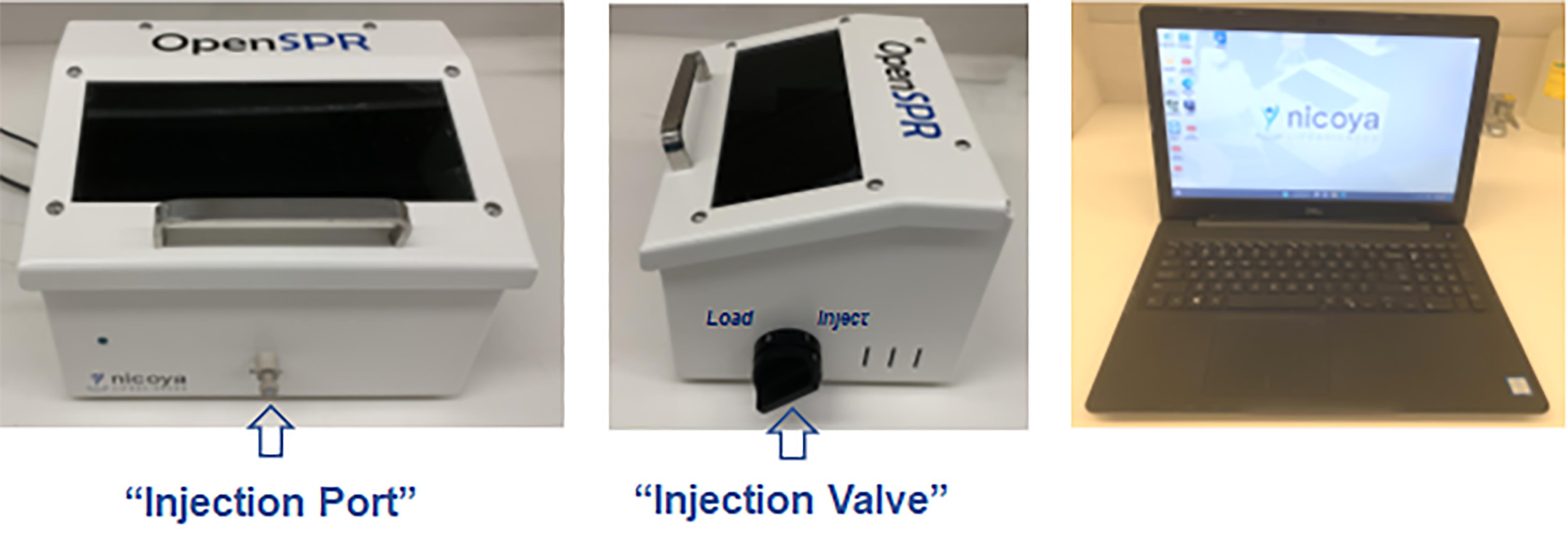
Figure 1. Photos of an OpenSPR 1-Channel Instrument and a laptop computer with installed Nicoya Lifesciences softwareNote: The OpenSPR is operated by the user manually, using a laptop computer with an Experiment Data Interface that allows the user to control various aspects of the OpenSPR instrument, such as changing running buffer, fluid flow rate, as well as sample injection. For instance, when a sample is manually injected into the Sample Loop via the Injection Port, the user then needs to switch the Injection Valve clockwise to the Inject position to initiate the delivery of the injected samples from the Sample Loop to the sensor.
Laptop computer with installed Nicoya Lifesciences software (Experiment Data Interface) for control of the instrument and fast real-time data acquisition (Figure 1).
Software and datasets
TraceDrawer Kinetic Data Analysis Software V.1.6.1 (Nicoya Lifesciences) for data processing and analysis of kinetic and affinity constants.
Procedure
文章信息
版权信息
© 2023 The Author(s); This is an open access article under the CC BY license (https://creativecommons.org/licenses/by/4.0/).
如何引用
Readers should cite both the Bio-protocol article and the original research article where this protocol was used:
- Zhu, C. S., Li, J. and Wang, H. (2023). Use of Open Surface Plasmon Resonance (OpenSPR) to Characterize the Binding Affinity of Protein–Protein Interactions. Bio-protocol 13(17): e4795. DOI: 10.21769/BioProtoc.4795.
- Zhu, C. S., Qiang, X., Chen, W., Li, J., Lan, X., Yang, H., Gong, J., Becker, L., Wang, P., Tracey, K. J., et al. (2023). Identification of procathepsin L (pCTS-L)–neutralizing monoclonal antibodies to treat potentially lethal sepsis. Sci. Adv. 9(5): eadf4313.
分类
生物化学 > 蛋白质 > 相互作用 > 蛋白质-蛋白质相互作用
免疫学 > 抗体分析 > 抗体-抗原相互作用
您对这篇实验方法有问题吗?
在此处发布您的问题,我们将邀请本文作者来回答。同时,我们会将您的问题发布到Bio-protocol Exchange,以便寻求社区成员的帮助。
Share
Bluesky
X
Copy link


